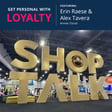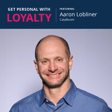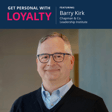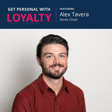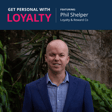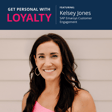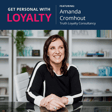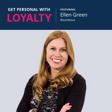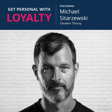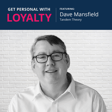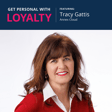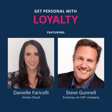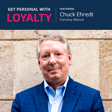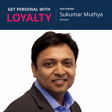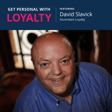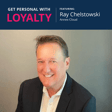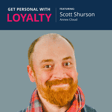Become a Creator today!Start creating today - Share your story with the world!
Start for free
00:00:00
00:00:01

Joyalty: The Harmony of Joy and Loyalty with Adam Posner
Never heard of the term ‘joyalty’? Then tune in to our latest podcast episode to hear Adam Posner, CEO of The Point of Loyalty, define it. Don’t miss Adam’s insider tips gained from joining and studying more than 113 loyalty programs and conducting his "For Love or Money" research for over a decade. Learn about the three Bs of loyalty, the six key currencies loyalty members care about, the six questions your brand should be able to answer around customer data and much more. Listen and subscribe today and let's forge a path to success with loyalty!
Transcript
Introduction to Loyalty
00:00:10
Speaker
Get personal with loyalty, where we're discussing using loyalty to deliver personalized, relevant customer experiences.
00:00:18
Speaker
Hello, and welcome to the next episode of Get Personal with Loyalty. I'm your host, Aaron Rees, and today I'm here with Adam Posner. He is the CEO of The Point of Loyalty. Welcome, Adam. Yeah, hi. Good morning, good evening, good afternoon, wherever you are. Hello, Aaron. How are you? I'm well, thank you. Excited to be chatting with you today. Thank you. Yes, me too. I've been waiting for this.
Adam's Career Journey
00:00:43
Speaker
Let's get started in sharing your background. Who are you? And something that I don't know is how did you get involved in loyalty? Because it really seems to be in your blood. And I'm curious how you became so passionate about it.
00:00:56
Speaker
Yeah, thanks for asking about the history. I'm from South Africa originally, and I arrived in Australia 35 years ago. And I landed in direct marketing in the early 90s, and finally enough started to do some promotions for retailers through a concept called Scratchy Sane. So a little scratchy, and they would give their customers a discount, and then they'd start collecting pieces of paper with names and addresses on.
00:01:21
Speaker
It started that the data got into my blood very early on. What did they do with those details? Put them in a spreadsheet? What did they do? Did they send them a direct mail? So data started the process back then in the early nineties. And you're really studying direct marketing and marketing for all of this time, 20 something years. But started my own agency in 2007 because a lot of data driven marketing by definition and loyalty programs are.
00:01:51
Speaker
a massive data collection tool, as you and I both know, and everyone knows. And because of that, I just thought loyalty programs must be amazing if they're collecting all this information.
The Art and Science of Loyalty Programs
00:02:01
Speaker
What's it all about? And I've collected, I think 113, if I remember, programs that I joined, walked the shopping centers, walked the streets, joined every possible program, wrote a little book about it, and suddenly realized I just love this. Because you know why I think you would also get this, is that
00:02:17
Speaker
I think it's both art and science. There's a creativity in it and there's the science and the data in it. It's just two sides of the brain that come together and I just love that. I think that's amazing to work in both sides.
00:02:32
Speaker
Yeah, I love that. I think there was a book about like the neuroscience of the customer and just so fascinating when you really start to dig in. And I always like to talk about the habit piece too, because there's the emotional side and there's the habit side, which I think we're going to be talking about probably later. I don't want to steal our thunder, but
00:02:48
Speaker
Yeah. How do people tick? Yeah, you know, humans. And whilst human behaviour is a whole, you can go deep, deep, deep on that. But the Royalty programs are there to recognise and reward and give the human being for a certain behaviour or certain outcomes. You've got to understand who they are.
00:03:06
Speaker
Why do they actually want to be surprised? And why do they want joy in their lives? Why do they want a saving? Some of it's surface level, we can say they want to earn some money to pay there every day, or they just want to be part of something. There's so many factors as to understanding it, but human behavior is fascinating, yes.
00:03:26
Speaker
I think what's interesting, when I try to tell people about loyalty or teach them about loyalty, it's liking it to a regular relationship and interpersonal relationship.
Emotional vs Programmatic Loyalty
00:03:38
Speaker
And how can a company become more personified to be able to do that, right? Yeah. And that's where this concept of what is loyalty. And that's a deep passion point of mine, because find in all the brands that I work with, all the chats that you and I are having,
00:03:56
Speaker
There's sometimes a confusion of the aspect of what loyalty actually is and not a loyalty program. As I always say, loyalty is not a program. What is loyalty? And I've been studying that part and you would know from the current research that I've asked consumers what they think loyalty actually is outside of belonging to a loyalty program.
00:04:18
Speaker
Yeah, that's so interesting. I think you know this. I co-founded Loyalty360 years ago. Yes. And when Mark and I were thinking of our name, we chose loyalty because we saw that as the end game. You need long loyal customers as an organization in order to be profitable. But as soon as we put that name out there, we were immediately associated with program. Yeah.
00:04:43
Speaker
which is, how do we continue to break that out? And there's so much more to it than that. But loyalty is a great enabler. A program is a great enabler. In fact, that's brilliant what you just said, Perfect. It is an enabler of a loyalty outcome, a program with all its tools, structures, and techniques.
00:05:02
Speaker
enables loyalty outcomes. But the question we've got to ask ourselves is, what are those loyalty outcomes? And that's what I've studied and now defined. And I guess I'll just jump in and share what I think they are and what our research has identified them as.
Three Pillars of Loyalty
00:05:18
Speaker
And there's three pillars to that. So loyalty is an outcome, is a behavior, as I define it. It's a transactional connection to a brand. So I buy more from the brand. I buy more often.
00:05:30
Speaker
over the longer term when there's a competitor set, it's chasing me. So behavioral loyalty or transactional loyalty is about the money in the first pillar. So that's a loyalty outcome, behavior and money or transaction. The next is Believe.
00:05:47
Speaker
So loyalty in terms of emotional connection. That's where I trust the brand. I love the brand and I'll tell everyone else about it that I recommend them. So we have behavioral loyalty and we have belief loyalty. So we've got the two B's happening. And the third B of what is loyalty is belonging.
00:06:08
Speaker
And that's where I identify with the brand's purpose and want to belong to their community. Now, behavior, belief, and belonging are all outcomes. And a loyalty program can enable, if I can use your word,
00:06:23
Speaker
can enable that behavior, that belief, and that sense of belonging. So to me, it's very clear. It's so clear in my mind. I wake up every single day. I know what loyalty is in my mind. Now, can a loyalty program, as you said, enable behavior, belief, and belonging, all three? I would say yes. And it comes down to your data. Correct.
00:06:49
Speaker
I love that. That's my job. Behavior and belief, I had the belonging. I know we talk about it a lot and talk about more of that community aspect, especially in more recent years, people around the globe thinking about sustainability and things like that. I think it's becoming more and more. I'm not sure it was as a parent before, maybe in the travel programs.
00:07:14
Speaker
Yeah, I think you're right. It's brand specific. So belonging by my definition is I did you know the brand's purpose. So does the brand actually have a clear vision and purpose? Not every brand does clearly identify or articulate that, but also their community. And not every brand has a passionate community. You've got it.
00:07:32
Speaker
think about the kinds of brands, thinking of pet companies. People love their pets. They could be part of the community who love their pets. Harley Davidson, people love Harley Davidson. They're part of that club, that community. There might be others. Even if we go widest, football, sports clubs are massive communities of people. Huge passion.
00:07:55
Speaker
And so their belonging loyalty would be huge. Maybe their transactional, you pay your membership, you buy, you go to the games and you spend money. But if you did their analysis on their behavior, the belief of the belonging, I reckon they'd be off the scales on belief and belonging.
00:08:12
Speaker
So we're going on a complete tangent by me asking this question, I'm sure. But you just made me think, do you when you're analyzing or working with clients, do you look at those three B's that way? Which one holds the most weight? Or should they all be equal? Or is it okay that they're different?
00:08:29
Speaker
Brand-specific. And in my study, I asked generically, consumers, thinking of brands generically, what do you think loyalty to their brand means to you, in general? And 58% said it's transactional. It's all about behavior. My loyalty to the brand is how much I spend there and how often or the longer term.
00:08:48
Speaker
And I think the next step after that is a 27% yeah, loyalty is about an emotional connection. So we've got 58 saying it's transactional, 27% George Dover course say it's about belief, and only 15% is about the deeper feeling of belonging and in emotional. Now, if you ask that same question to the community of Harley Davidson, it might be a totally different way to answer your question. It's brand specific.
00:09:15
Speaker
I bet there's also what the person says, but then also how they actually act. He's a whole nother. If we want to talk about the validity of research, I think research is a guide. It's not an absolute statement. It's a statistic in effect, and it's got a sample size, and it's got statistical relevance.
00:09:37
Speaker
It's either say, do you gap is a well-known, I say I'll do this, but will I actually do it? And that's the reality of business. You've got to go out there and ask them to do it and let's see if they do it.
00:09:50
Speaker
Yeah. Yeah. And I guess track it so that I've enjoyed this conversation and we dug in the middle of what we wanted to talk about. So we can take a step back as you hint into it here as we've been talking, but you for what, the last 16 years you've been doing a report that you call for love or money and you recently released the latest
Insights from 'For Love or Money'
00:10:11
Speaker
research.
00:10:12
Speaker
It's 11 years of doing a study, 16 studies over that time. Australia, New Zealand, and one B2B study. They're all consumer studies, and I've got tracking now in certain areas way back to 2013 from the first study. There's lots of tracking and trends that I've been monitoring on certain areas, but every year there's also new ideas or insights.
00:10:35
Speaker
So my mission with the research is a couple of things. One is to keep learning. I'm very curious to understand consumers' attitudes to programs. And that's how I push myself to, for example, I'm already planning next year's study. I've already got five or six questions that I thought, oh, that's really interesting. Let me see what that would look like.
00:10:55
Speaker
So to keep learning and just like you do with the podcast, this is a different frame. And then the other is a mission to give loyalty marketers insights to provoke them and prod them to challenge the research or to go and say, oh, would that be relevant for my brand and my business? Maybe not. But that's the idea is to keep lifting us to be better.
00:11:17
Speaker
I love it. And so in reviewing this year's executive summary, it appears that you went down some different paths than you had in the past. Does that happen every year? And if this year is special, what were you experiencing or seeing in the market that made you expand the scope?
00:11:37
Speaker
This is an independently commissioned piece of work. I give it to an independent researcher and they do all the sample sizing and all the quotas. My research I've worked with for 11 years. And every year she says, Adam, if you add any more, it's going to A, cost you a lot more and B, no one will finish it.
00:11:55
Speaker
And so this year, unfortunately, I really pushed the relationship because I couldn't help myself. There were so many things I wanted to validate or understand. So this year has gone way more than ever before. It's just from the page numbers, if that's any indication, 125 pages of the main report, and I've never gone over 19. To answer your question, why? Because there were certain areas this year that I'd never seen in research before.
00:12:22
Speaker
And I wanted to ask certain questions and I couldn't help myself. In the nine sections that the report has, there's a very new section on an area that I think a lot of loyalty programs either don't invest enough in, but it's like a sleeping giant, which is your team, especially retail royalty programs, that point of sale, their engagement with your program, how important they are. I call them royalty champions.
00:12:50
Speaker
And for the very first time this year, I asked consumers in the research, what impact team members of a brand at point of sale hands on them to join a program as well as to continue to interact with a program.
00:13:09
Speaker
So that's never been done before. I've never seen any research. And now I've looked at four factors for acquiring members upon us at level and three factors for your continuous engagement.
Role of Team Members in Loyalty Programs
00:13:21
Speaker
And I try to get to see the weighting of those and the importance of those. And that's a very new area. So you ask me what's new, that is a whole new area, a whole new section. Love it. Did you have any aha moments or was it pretty much what you'd expect?
00:13:38
Speaker
Yeah, I never know what to expect. Even if I say to myself, ah, look, these four areas, they're all important, I would say to myself, but I just wonder how important consumers think they are. And so in that specific section on team members, the areas I looked at were to acquire a member at point of sale, there were four areas and they were making it easy for you to actually join. Does the team member actually make it quick and easy? And that's also got to do with the point of sale systems and how much data you're asking for and that sort of stuff.
00:14:07
Speaker
proactively asking you to join. Hey, Aaron, would you like to join this program? It's an amazing program. It's got this and this, and you can get this. And finally, the knowledge to get this. So all in, in 25 words or less, or in 10 seconds or less. So those are the four factors that influence you to join Aaron. Yeah. And they were all equally, very closely weighted in terms of their importance. So I didn't know whether one was more, cause I asked them to rank them against the influence, their influence on you to join.
00:14:35
Speaker
And they were all very close. And my call-out, my point on this was for brands who have loyalty programs, which have a retail network, all four are important. Make it easy. Show you've got the knowledge about the program. Be excited and enthusiastic and proactively ask. You've got to have all four.
00:14:57
Speaker
I'm not surprised by that because even just as a consumer, there are some places where there's a program and you're looking around going, okay, who's going to help me? Who's going to tell me about this? And you're almost intimidated to ask because no one's offering it to you and you would expect it to at least have some signage or something. So I think you do need that. And I know in some of the conversations I've had over the years debating with
00:15:25
Speaker
clients and prospects around, do you involve your employees in the program? I've had a lot of companies say, no, they have their own benefits and perks because they get big discounts on whatever they're selling. But I really think if you're going to have a loyalty program, having the
00:15:42
Speaker
associates involved and having them really, truly experience it and seeing firsthand how it works is really important to get to that enthusiasm. I would think it's hard to have that enthusiasm without that. I think you're spot on. I'd find the same sort of challenge when we say should your team members join the consumer loyalty program or customer facing program? And I get the same answers. You know, they've got their own employee benefits program.
00:16:09
Speaker
We don't want them. Plus there's fraud and risk areas that can happen where they give themselves points. So besides that, it's a bit of a paradox. Yeah. You want them to know and experience the program, but you've also got to balance what they're already getting. I'm with you. So first question we asked, can your team members join the program?
00:16:28
Speaker
And we urge you to say yes. We urge you to say yes. Great. I think that's a wonderful call out you have included because it's super important. As I was looking through the materials you sent me about the research, there were a couple of areas that I thought were pretty interesting where programs have improved in recent years. And then also loyalty program strategy at team engagement.
00:16:53
Speaker
those two areas, and maybe the team engagement is what you just shared. So the loyalty strategy piece, and then how have programs changed or improved? Those were intriguing to me. I don't know where you had your aha moments, but... That one really is actually one of my favorites, and perhaps you asked me earlier. It's terrific for loyalty program marketers because it's been a tracking question since 2016. That's got a huge history behind this. And the question we asked, I looked at six areas,
00:17:21
Speaker
In terms of asking consumers, do you think loyalty programs have improved to date? So how have they improved in these six areas? And the six areas that we looked at were earn rate. So in other words, have programs improved in recent years and how quickly you can earn your awards? Have they improved in the technology in terms of like integrated payments and an app? Has there been any improvement in that? Has there been improvement in how simple the programs are, the simplicity aspect?
00:17:49
Speaker
Have there been improvement in non-financial rewards being offered? Any improvement in surprise and delight or that word we might talk about a bit later called joyalcy? Has there been any improvement in personalized and relevant communications? So those are the six areas we first asked about. Have they proved to date?
00:18:09
Speaker
And there has been some, consumers have said, yes, those areas have improved, earn rate, technology, simplicity, non-financial rewards, surprise and delight, and cost. Whereas the six, that's how they rank.
Evolving Loyalty Programs
00:18:22
Speaker
But then I asked, and where do you think they need to improve in the future?
00:18:27
Speaker
And I think that's a guiding light for loyalty program managers, which is consumers in our study said earn rate, still got improved. Now I'm not surprised by that. Everyone wants to earn their rewards quicker. Yeah. If you can get in for free, why not? You can get in a bit quicker because achievability with a program depends on the structure, depending on the category and all of that. But earn rate is fundamentally what people want to get to their rewards quicker in most cases.
00:18:53
Speaker
But number two, which jumped from number five, so improved to date was five was surprise of the life, but what they want in the future is more surprise and delight, more joyalty, as I've called it. Then they want more non-financial rewards. So it's not only about the money, it's about the experiential and anything outside of the money.
00:19:15
Speaker
And then it's comms being more personalized and relevant. Simplicity and technology, it seems to me that's improved a lot to become more simple. Technology has improved thanks to the likes of Annex Cloud and various other people in the market. So those top four, which is earn rates, surprise and delight, non-financial rewards, and comms being more personalized and relevant.
00:19:38
Speaker
Those are near and dear to my heart. Certainly when we're out talking to people, it seems like those are the things that are where people should be focusing. It goes back to the customer piece of show me me. It's a yes, you can get me my points faster or my value faster. But in reality, if you can make my life easier and appreciate me, I'll do a whole lot more for you. Absolutely. Yeah.
00:20:02
Speaker
Yeah, I think it's just a nice little six-factor analysis. Loyalty program managers are listening today around the world. It's very easy to do your own little research study asking your members, where's your program improved? And you can use those six areas. And where should we improve in the future? Great point. Easy. Which we should be doing and talking to our members and getting feedback from them on a regular basis too. Absolutely.
00:20:29
Speaker
And then, so loyalty program strategy is evolving or changing as well.
00:20:36
Speaker
The concept of strategy in this research is more about giving people who run programs insights to their strategy. It's very much just some guiding lights around, as I've said, loyalty program structures. I don't do a lot in this study around, should it be a points program? Should it be a cashback program? This year, I've done it three years ago and I'll do it again next year. But I haven't analyzed, should we say structural elements, tiers versus no tiers.
00:21:04
Speaker
coins versus cash, but I haven't done any of that this year. So structurally, with mechanics, I did do gift cards, understanding the impact of gift cards and how important they are in a reward catalog base. Do members actually want more or less gift cards as a redemption option? So it's quite tactical.
00:21:24
Speaker
But overwhelmingly gift cards are seen to be an important redemption option for programs where possible, because members get choice out of that and a range of other elements. But strategically, and depends on what you mean by strategy, I guess I'll ask you, when you're thinking strategically around a loyalty program, what factors would you consider? I think it's a lot of the things you just went through now that I'm reflecting on the questions that Eric has.
00:21:53
Speaker
One of the things that we talk a lot about is engagement. And so you talked about the transactional, your three B's. And I guess in a sense, engagement probably falls into the two, the belief and the belonging. But curious if you did anything on, like we talk a lot about
00:22:17
Speaker
having a customer be more of an advocate to maybe go out and hashtagging your brand or as part of that community maybe uploading pictures. I don't know if you're apparel like your clothing you mentioned some of the sporting events and such and so somebody who's a big fan of a particular team being able to take pictures from and be able to share them
00:22:42
Speaker
And having that be recognized or rewarded as part of a program, is that something that you're seeing? That's really interesting. Sometimes it's more terminology and we're saying the same thing using different words. You talk about engagement from that point of view. And now I didn't look.
00:22:58
Speaker
about the specific behaviours that someone might do. Recommendation or referring, whether you use a social channel or whether you tell somebody over a coffee is part of the belief loyalty. Do people recommend? And recommendation is an engagement metric. Yes, it is looked at in different aspects of the research.
00:23:16
Speaker
In terms of hashtagging and sharing and showing pictures and all of the getting points, socials and so by definition getting people to do something, act on engage with a brand or program. That's to me very much sort of gamification aspect, but also an experiential elements. What are we doing to drive them to experience our program and as you say, share with the greater community.
00:23:42
Speaker
But I looked within the six currencies. I'm not sure if you recall that in the study, there's a section six is called the collection of six currencies that loyalty program members care about. And in that pyramid of six currencies, there's a financial currency showing me the money. There's the experiential currency, which is environments of magic to my life.
00:24:04
Speaker
There's the utility or functional currency, which is make my life easy and simple. There's the personal currency, which has made me feel special, which is the ego and exclusivity. There's the choice currency that give me the choice. Don't just tell me what I'm going to get. Give me a choice currency. And the other currency at the top is the social or community currency and causes. Within each of those, you've got elements of engagement.
00:24:31
Speaker
I guess people have to get the report to see that. That's a summary, that pyramid's there and that's freely available, so that's a great guide. I've had a lot of good feedback on that, the six currencies, because it's a great framework to look at your program proposition and just go through each of those six and see where your program and your customers either need more of or less of.
00:24:57
Speaker
I think a lot of times maybe the marketer side thinks about maybe just a single currency. I know a lot of conversations we're having today, people are like, I don't want points. I don't want my program to be points. Like, OK. But then they want it to be hats or chocolates. But it's still just that financial piece. It's not some of those other aspects. Another thing I tend to preach on a lot is recognition. I think there's a lot to recognition that
00:25:26
Speaker
Most loyalty initiatives really miss. And I think it goes a long way for the emotional aspect that you're talking about and probably even the belonging. You're right. It's all of those that you said. And in the pyramid, it goes transactional to emotional because everything from experiential and utility, personal choice and social community, all of those drive emotional senses of
00:25:51
Speaker
If you give me a moment of joy, or you invite me to an exclusive event, or you say, hey, Aaron, you're in our top 250, you're special to us. You have something that you wouldn't have expected. Or even if the communication gets you and knows that you, all of those make you feel closer to the program and heads to the brand.
00:26:13
Speaker
Let's look at these six currencies of collection. And it's a generic term, currencies, because we talk about currencies in the points currency, but that's more specific. This is strategic. Yeah, I agree. So on the reporting side or within your report, any other like aha moment that you had when you saw the results that maybe we didn't cover?
Data Privacy Concerns
00:26:39
Speaker
There is so much, but another aha, which is something that everywhere in the world, we've got to be aware of, which is the data privacy trust and transparency and the breaches that are happening across different brands around the world. And where's my data going? Who's using it? Why are you asking for it? Is it safe? How are you protecting it? And loyalty programs, which as you and I know, and the community who listen, data is at the core.
00:27:09
Speaker
and trust and sensitivity comes from how and why you use my data when I join your program. So the area in the last part of the report is all about that and we identified six areas of concern that loyalty program members have when they exchange their data with a program.
00:27:31
Speaker
And the six areas we looked at were, who has my data? So if I give it to you, who actually has access to it? So it's the first one. Security of the system. So what are the, what's the security on where you're storing my data? Protection, knowing how the loyalty program is actually protecting my data. Using, used, knowing how the loyalty program is going to use the data.
00:27:57
Speaker
time? How long are you going to hold on to it because there's certain programmes that ask for some specific information? And why? The reason why the data is being requested. So those six areas of who security protection use time and why? And we ask them, how concerned are you about those six areas when you hand over your data?
00:28:21
Speaker
And we had a ranking of very concerned, moderately concerned, down to not at all concerned. But it was heavily weighted to very concerned across three areas. Who has access to my data, security of systems, security of the systems where you're holding my data, and protection, knowing how programs are protecting my data with the top three. However, when you looked at all of it, all six are really important.
00:28:48
Speaker
I'm really curious on number two, the security of the system. The other things I think if you're in reading program rules or terms and conditions or something, I would think most often those
00:29:03
Speaker
things are probably covered. I think most organizations try to say, if I'm going to collect this data, here's how I'm going to be using it. But the actual system, I find that interesting. And even if there is a path for a consumer, this is me more private with my consumer hat on, to even figure out what systems and what good would it do if I knew? It's really interesting you bring that up. It might not be
00:29:27
Speaker
utility for you. It might not be that you really need to know, but it's about the availability or it's almost like a subconscious thing. So it could be somewhere in the rules and systems. It might not be on a poster in the store, might not be, we have got XYZ security systems, two factor authentication, which I'm sure is worldwide now. Subconsciously it gives
00:29:50
Speaker
your member, if they're signing in, that element, are they really are protecting it? It might add a little bit of time to the process or a little bit of friction, but it also makes you feel peace of mind. Whenever I have to do the two-factor authentication process, I think, oh great, they are protecting my data. So that's like a process and a system.
00:30:10
Speaker
That makes perfect sense. I took it way too literally. And that's probably a good point in being able to make sure that we are doing those things and that those things are visible, where we are protecting. And maybe there's a way to explain some of it so people feel more comfortable. Visibility.
00:30:28
Speaker
You said that, and I think that's really important. Communicating, I got a communication from a program that I'm a member of, and it was specifically related to, and it's because of what's been happening. Dear member, or dear Adam, you are a member of a program. We just want to reassure you, this is how we protect you, your data. And they gave me a list of seven things. There's an email, I read it in, I stored it away, or I'm only being deleted. It didn't matter. What happened is they communicated, and now I know.
00:30:55
Speaker
Yeah. Easy. Just communicate. It's the visibility and being open, everybody. Yeah, correct. So you've alluded to it. You've mentioned it. We need to know what it's all about.
Introducing 'Joylty'
00:31:08
Speaker
Joylty. My favorite. Joylty. So Joylty is a word I found reading a book.
00:31:16
Speaker
The book is called Brand Currency. It's about Amazon. But the author, Steve, says he didn't actually talk about it in the context that I've now redefined it as. So I've borrowed the word and I've given it to your efforts, but I've redefined it in loyalty programs because I love it so much. It's just one word that says so much.
00:31:37
Speaker
And Joylty is your members feeling of maximum joy and delight from one or a series of moments of magic. I call them moments of magic. They're called Moms by your loyalty program. So it is the old surprise and delight. It's just a new way of phrasing it. It's not clearly defined. And I've got a seven stage process that I've developed and tested and put in with clients on how to build Joylty moments into your program.
00:32:05
Speaker
And just for your audience, it's a free paper that I've written on the joyalty program is the new loyalty program, and they can download that for free from my site.
00:32:14
Speaker
The point is that I actually wanted to ask consumers how loyalty programs can incorporate more loyalty moments. And I gave a list of 13 different ones that I'd found around the world, everywhere in the world where brands were doing some amazing unexpected random acts of kindness and all moments of joy. And I put that into the research, those 13. And that's where one of the most surprising
00:32:43
Speaker
You asked me earlier on outcomes, maybe a little bit disappointing, but one of the 13 elements was the happy birthday gift or award. Staple element. It's like your meat and potatoes on your loyalty program. Yeah. But members still want it. That's interesting. I've heard a lot of debate about that. Different people saying.
00:33:07
Speaker
You don't want to do birthday. Who cares about that? I think probably somewhere within all of us, we're still a kid at heart and we still want that gift. I love what you just said. And yet maybe it's because we as marketers of programs are getting a bit bored with it. But my call out here is we can't be bland and boring with that birthday gift. So here's the challenge.
00:33:30
Speaker
What can you do then that's not just the normal hire and happy birthday. You have $5 when you spend a hundred. First of all, you got to make you spend a hundred to get five. Is that great or not? You got to do something. And I don't know, you know, specifically because it's brand specific, but what can you do differently with your happy birthday? Yes. And to your point, maybe the surprise and delight, what other experiential type things could you be offering? Yeah.
00:33:59
Speaker
And exactly. So I think that creativity, we talked about the art and the science and the creativity of Joylty is you got to look for something unexpected. So what would your member expect? What could you do that is unexpected? The other thing about that is your tone of voice, your brand. Is your brand a very straight bank or whatever it is? Or is there some sort of fun in your brand that you can have some fun with your Joylty?
00:34:23
Speaker
I love it. I love the term. I think you and I have gone back and forth on LinkedIn with it a little bit too. It's such a fun word. Obviously, it starts with joy and being able to continue to think about how can you spread joy or create moments of magic in your initiatives and in your overall customer experience, I think is a really nice foundational way to think about
00:34:47
Speaker
what you're trying to accomplish and what you're doing and keeping that in, I think what you're doing is working very hard to keep a tab of mind to all of us. And I think it's important because having that perspective and that outlook will challenge you to do things that are more unique and more exciting and build more ultimately engagement and loyalty. And emotional connection, which we spoke about.
00:35:10
Speaker
Ding, ding, missed that. It's a very big part of my day, Joylty. I'm always looking for Joylty moments. There's many that people post up on LinkedIn, there are many brands doing things here and there that I just saw a grocery group recently put a little sticker on certain products on their shelves and the little sticker kind of was like, this item's free, it's on us. So it's like that little element.
00:35:34
Speaker
The piece that happened there, it says there, and the people went, wow, and they took a photo and they put it on the socials. And then it just builds, it's that whole advocacy ripple effect, sharing these really great experiences, and it's just going to build more. It continues to ripple and be broader. I love it. Yeah. I'll try to see where I can find those moments and share with you as well. Yeah, please do. This has been such a pleasure, Adam. Anything else as we're wrapping up to add?
00:36:02
Speaker
No, I just thank you for sharing this conversation with me and giving me the opportunity to share the joy, as I say, about bits of magic and the insights and helping loyalty marketers be better every day because we have a great industry. It's very strong. It's very buoyant. We're all playing our little part in keeping our industry vibrant and ultimately serving the brand that has the program so that it's a profitable and sustainable
00:36:27
Speaker
strategy for them to drive those loyalty outcomes, but giving joy and financial savings or whatever it is back to the member or the customer. Because it is a value exchange and we've got to remember the customer is fundamentally wanting to be loyal if you give back and over and above everything else that you offer. Thank you for giving me the opportunity to chat with you.
00:36:50
Speaker
Oh, I'm thrilled with it. Thank you. I've really enjoyed the conversation. I've learned a ton. As we wrap here, you did mention your website. That's where we can find the Joylty paper and the research. But what is the website? Thepointofloyalty.com.au. Thepointofloyalty.com.au. And yeah, there's lots of free resources. I write blogs every week. The Joylty paper's free. The executive summary of my report is free.
00:37:17
Speaker
If they want the full report, they can purchase the full 100-page report up to them. But there's plenty there to help marketers with insights to improve their programs. Terrific. We'll go to the point of loyalty. And also, you can reach out to Adam on LinkedIn. I find you there all the time. Thank you so much. It's been such a pleasure.
00:37:40
Speaker
Thanks for listening to this episode of Get Personal with Loyalty. Join us next time for more loyalty insights. Until then, dare to dream. Let Annex Cloud help make your dreams a reality. Visit annexcloud.com. See you soon.
